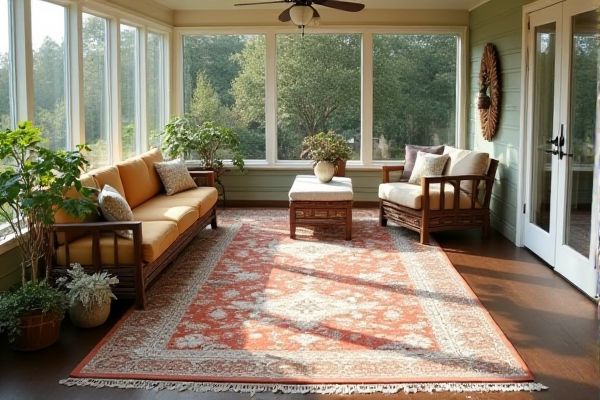
Indoor-outdoor rugs are designed with durable, weather-resistant materials ideal for sunrooms that experience high foot traffic and occasional moisture, while indoor rugs provide softer textures and more intricate designs suited for fully enclosed spaces. Explore the rest of the article to discover which rug will best enhance your sunroom's comfort and style.
Table of Comparison
| Feature | Indoor-Outdoor Rug | Indoor Rug (Sunroom) |
|---|---|---|
| Material | Durable synthetic fibers (polypropylene, polyester) | Natural fibers (wool, cotton) or synthetic blends |
| Weather Resistance | Waterproof, UV resistant, mildew resistant | Limited moisture resistance, not UV resistant |
| Durability | High - withstands heavy foot traffic and outdoor conditions | Moderate - suitable for light indoor use and sunroom environment |
| Maintenance | Easy to clean with hose or mild detergent | Requires regular vacuuming and occasional spot cleaning |
| Comfort | Moderate - less plush but functional | High - softer and more comfortable underfoot |
| Design Variety | Wide range of patterns suited for indoor and outdoor aesthetic | Wide variety with emphasis on indoor design styles |
| Use Case | Versatile: patios, decks, sunrooms, entryways | Primarily indoor spaces like sunrooms, living rooms |
Introduction to Sunroom Rug Choices
Sunroom rug choices require careful consideration of material and durability due to varying exposure to sunlight and moisture. Indoor-outdoor rugs offer enhanced resistance to fading, mildew, and wear, making them ideal for sunrooms with direct sunlight and occasional humidity. In contrast, indoor rugs prioritize comfort and aesthetic appeal but may degrade faster in sun-exposed environments without specialized treatment.
Key Differences: Indoor-Outdoor Rugs vs Indoor Rugs
Indoor-outdoor rugs are designed with durable, weather-resistant materials like polypropylene, making them ideal for sunrooms where moisture and sunlight exposure occur, while indoor rugs prioritize softness and aesthetics for dry, climate-controlled spaces. The weave and backing of indoor-outdoor rugs prevent mold and mildew, whereas indoor rugs may absorb moisture and deteriorate if exposed to outdoor elements. Your choice hinges on whether you require resilience against outdoor conditions or the plush comfort suitable for purely indoor environments.
Material Comparison: Durability and Texture
Indoor-outdoor rugs are typically made from synthetic fibers like polypropylene, offering high durability and resistance to moisture, mold, and fading, making them ideal for sunrooms exposed to varying humidity and sunlight. Indoor rugs for sunrooms often use natural materials such as wool or cotton, providing a softer texture and more luxurious appearance but with less resistance to moisture and wear. Choosing between these depends on the balance needed between durability against weather elements and the desired comfort and aesthetic for the sunroom space.
Moisture and Stain Resistance: Which Is Better?
Indoor-outdoor rugs are designed with synthetic fibers like polypropylene that offer superior moisture and stain resistance, making them ideal for sunrooms where humidity and spills are common. Indoor rugs, typically made from natural fibers such as wool or cotton, absorb moisture more easily and can develop stains or mold without proper care. Choosing an indoor-outdoor rug ensures better durability against moisture and stains, protecting Your sunroom flooring while maintaining a clean appearance.
Comfort and Aesthetics in Sunrooms
Indoor-outdoor rugs offer superior durability and moisture resistance compared to traditional indoor rugs, making them ideal for sunrooms with fluctuating humidity levels and direct sunlight exposure. These rugs are designed with materials like polypropylene, providing a comfortable texture underfoot and maintaining vibrant colors despite sun exposure, enhancing the aesthetic appeal of sunroom spaces. Indoor rugs, while softer and often more plush, may fade or deteriorate quickly in sunrooms, making indoor-outdoor rugs a practical choice for balancing comfort and long-lasting beauty.
Maintenance and Cleaning Considerations
Indoor-outdoor rugs are designed with durable, weather-resistant materials that make maintenance and cleaning in sunrooms easier, as they resist fading, mold, and mildew. Indoor rugs for sunrooms often require more careful cleaning to avoid damage from sunlight and moisture, necessitating gentle vacuuming and occasional professional cleaning. You can extend the life of your rug by selecting an indoor-outdoor option that withstands high traffic and exposure to sun without compromising appearance or quality.
Color and Pattern Options: Enhancing Your Sunroom
Indoor-outdoor rugs offer a wider range of vibrant color and pattern options designed to withstand sun exposure and resist fading, making them ideal for sunrooms with abundant natural light. These rugs often feature UV-resistant dyes and durable materials that maintain their brightness and intricate patterns over time, unlike typical indoor rugs that may fade or wear quickly in sunlit areas. Choosing an indoor-outdoor rug enhances your sunroom's aesthetic appeal with lively designs that complement both indoor comfort and outdoor durability.
Cost Analysis: Budgeting for Your Sunroom Rug
Indoor-outdoor rugs typically cost more than indoor rugs due to their durable, weather-resistant materials designed for sunroom environments. Your budgeting should factor in the initial investment and long-term value, as indoor-outdoor rugs often last longer and require less maintenance in sun-exposed spaces. Considering the purpose and expected wear, an indoor rug may be less expensive upfront but might need earlier replacement in a sunroom setting.
Environmental and Allergy Concerns
Indoor-outdoor rugs are designed with synthetic fibers like polypropylene, which resist mold, mildew, and allergens, making them ideal for sunrooms with fluctuating humidity and exposure to dirt and moisture. Indoor rugs typically use natural fibers such as wool or cotton, which can trap allergens and harbor dust mites, posing challenges for allergy sufferers in environments where ventilation is limited. Choosing an indoor-outdoor rug for your sunroom helps minimize environmental allergens and ensures a healthier, low-maintenance space.
Choosing the Best Rug for Your Sunroom
Selecting the best rug for your sunroom involves balancing durability and style; indoor-outdoor rugs are crafted from weather-resistant materials like polypropylene, making them ideal for spaces exposed to sunlight and moisture. Indoor rugs, while softer and more plush, may fade or deteriorate quickly when placed in a sunroom with high UV exposure. Prioritize rugs with UV protection, easy-clean fibers, and mold resistance to ensure longevity and sustained aesthetic appeal in sunroom environments.
 homyna.com
homyna.com